5. Steroid receptors have several independent domains
21.5 Steroid receptors have several independent domains |
| Key terms defined in this section |
| Receptor is a transmembrane protein, located in the plasma membrane, that binds a ligand in a domain on the extracellular side, and as a result has a change in activity of the cytoplasmic domain. (The same term is sometimes used also for the steroid receptors, which are transcription factors that are activated by binding ligands that are steroids or other small molecules.) |
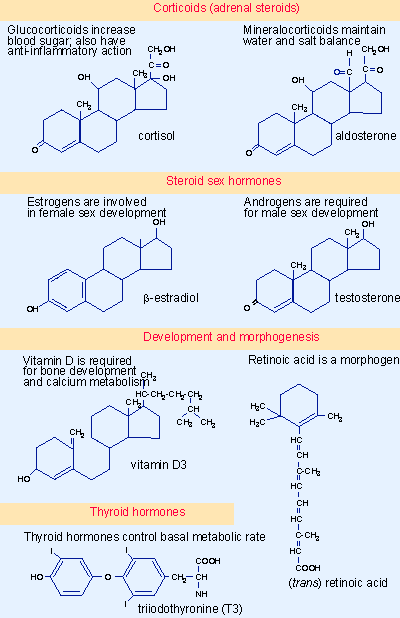 |
Figure 21.6 Several types of hydrophobic small molecules activate transcription factors. Corticoids and steroid sex hormones are synthesized from cholesterol, vitamin D is a steroid, thyroid hormones are synthesized from tyrosine, and retinoic acid is synthesized from isoprene (in fish liver). Multiple figure |
Steroid hormones are synthesized in response to a variety of neuroendocrine activities, and exert major effects on growth, tissue development, and body homeostasis in the animal world. The major groups of steroids and some other compounds with related (molecular) activities are classified in Figure 21.6.
The adrenal gland secretes >30 steroids, the two major groups being the glucocorticoids and mineralocorticoids. Steroids provide the reproductive hormones (androgen male sex hormones and estrogen female sex hormones). Vitamin D is required for bone development.
Other hormones, with unrelated structures and physiological purposes, function at the molecular level in a similar way to the steroid hormones. Thyroid hormones, based on iodinated forms of tyrosine, control basal metabolic rate in animals. Steroid and thyroid hormones also may be important in metamorphosis (ecdysteroids in insects, and thyroid hormones in frogs).
Retinoic acid (vitamin A) is a morphogen responsible for development of the anterior-posterior axis in the developing chick limb bud. Its metabolite, 9-cis retinoic acid, is found in tissues that are major sites for storage and metabolism of vitamin A.
We may account for these various actions in terms of pathways for regulating gene expression. These diverse compounds share a common mode of action: each is a small molecule that binds to a specific receptor that activates gene transcription. ("Receptor" may be a misnomer: the protein is a receptor for steroid or thyroid hormone in the same sense that lac repressor is a receptor for a β-galactoside: it is not a receptor in the sense of comprising a membrane-bound protein that is exposed to the cell surface.)
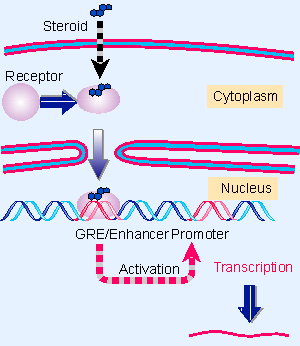 |
Figure 21.7 Glucocorticoids regulate gene transcription by causing their receptor to bind to an enhancer whose action is needed for promoter function. |
We know most about the interaction of glucocorticoids with their receptor, whose action is illustrated in Figure 21.7. A steroid hormone can pass through the cell membrane to enter the cell by simple diffusion. Within the cell, a glucocorticoid binds the glucocorticoid receptor. (Work on the glucocorticoid receptor has relied on the synthetic steroid hormone, dexamethasone.) The localization of free receptors is not entirely clear; they may be in equilibrium between the nucleus and cytoplasm. But when hormone binds to the receptor, the protein is converted into an activated form that has a 10 increased affinity for nonspecific DNA; the hormone-receptor complex is always localized in the nucleus.
The activated receptor recognizes a specific consensus sequence that identifies the GRE, the glucocorticoid response element. The GRE is typically located in an enhancer that may be several kb upstream or downstream of the promoter. When the steroid-receptor complex binds to the enhancer, the nearby promoter is activated, and transcription initiates there. Enhancer activation provides the general mechanism by which steroids regulate a wide set of target genes.
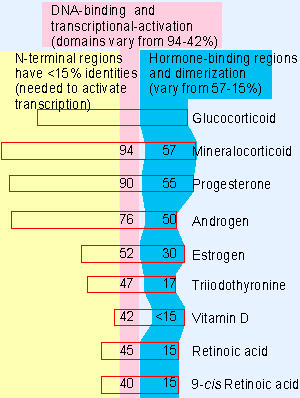 |
Figure 21.8 Receptors for many steroid and thyroid hormones have a similar organization, with an individual N-terminal region, conserved DNA-binding region, and a C-terminal hormone-binding region. |
Receptors for the diverse groups of steroid hormones, thyroid hormones, and retinoic acid represent a new "superfamily" of gene regulators, the ligand-responsive transcription factors. All the receptors have independent domains for DNA-binding and hormone binding, in the same relative locations. Their general organization is summarized in Figure 21.8 (for review see Evans, 1988).
The central DNA-binding domains are well related for the various steroid receptors, and remain identifiable in the other receptors. Some ligands have multiple receptors that are closely related, such as the 3 retinoic acid receptors (RARα , β, γ) and the three receptors for 9-cis-retinoic acid (RXRα , β, γ). The conservation of sequence probably reflects the common need to bind to DNA, while the variation is responsible for the selection of different target sequences. The act of binding DNA cannot be disconnected from the ability to activate transcription, because mutations in this domain affect both activities.
The N-terminal regions of the receptors show the least conservation of sequence. They include other regions that are needed to activate transcription.
The C-terminal domains bind the hormones. Those in the steroid receptor family show relationships ranging from 30 V57%, reflecting specificity for individual hormones. Their relationships with the other receptors are minimal, reflecting specificity for a variety of compounds Xthyroid hormones, vitamin D, retinoic acid, etc.
The C-terminal region regulates the activity of the receptor in a way that varies for the individual receptor. If the C-terminal domain of the glucocorticoid receptor is deleted, the remaining N-terminal protein is constitutively active: it no longer requires steroids for activity. This suggests that, in the absence of steroid, the steroid-binding domain prevents the receptor from recognizing the GRE; it functions as an internal negative regulator. The addition of steroid inactivates the inhibition, releasing the receptor’s ability to bind the GRE and activate transcription. The basis for the repression could be internal, relying on interactions with another part of the receptor. Or it could result from an interaction with some other protein, which is displaced when steroid binds.
The interaction between the domains is different in the estrogen receptor. If the hormone-binding domain is deleted, the protein is unable to activate transcription, although it continues to bind to the ERE. This region is therefore required to activate rather than to repress activity.
Each receptor recognizes response elements that are related to a consensus. These response elements have a characteristic feature: each consensus consists of two short repeats (or half sites). This immediately suggests that the receptor binds as a multimer, so that each half of the consensus is contacted by one subunit (reminiscent of the λ operator-repressor interaction described in 11 Phage strategies).
The response elements for the various receptors may be either palindromes or direct repeats in which the half sites are separated by 0 V4 base pairs whose sequence is irrelevant. Only two types of half site are used by the various receptors. Their orientation and spacing determine which receptor recognizes the response element. This behavior allows response elements that have restricted consensus sequences to be recognized specifically by a variety of receptors. The rules that govern recognition are not absolute, but may be modified by context, and there are also cases in which palindromic response elements are recognized permissively by more than one receptor (for review see Yamamoto, 1985).
The receptors fall into two groups:
- Glucocorticoid (GR), mineralocorticoid (MR), androgen (AR), and progesterone (PR) receptors all form homodimers. They recognize response elements whose half sites have the consensus sequence TGTTCT. The half sites are arranged as palindromes, and the spacing between the sites determines the type of element. The estrogen (ER) receptor functions in the same way, but has the half site sequence TGACCT.
- The thyroid (T3R), vitamin D (VDR), retinoic acid (RAR), and 9-cis-retinoic acid (RXR) receptors form heterodimers, which recognize half elements with the sequence TGACCT. The half sites are arranged as direct repeats, and recognition is influenced by their separation as follows:
1 bp- RXR
3 bp- VDR
4 bp- T3R
5 bp- RAR.
This pattern of recognition in the second group applies for dimeric receptors in which one subunit is the receptor on the list, and the other is RXR (so the first on the list is actually a homodimer). The requirement for heterodimer formation was discovered because retinoic acid and thyroid hormone receptors (RARs and T3Rs) bind much more efficiently to their target sites in the presence of RXR. The heterodimeric receptors respond to the ligand for the first subunit, and apparently do not require RXR to bind its ligand. These receptors can also form homodimers, which recognize palindromic sequences.
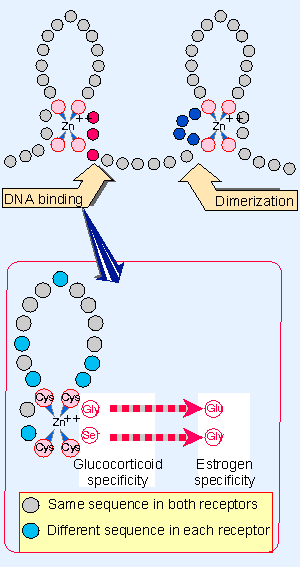 |
Figure 21.5 The first finger of a steroid receptor controls specificity of DNA-binding (positions shown in red); the second finger controls specificity of dimerization (positions shown in blue). The expanded view of the first finger shows that discrimination between GRE and ERE target sequences rests on two amino acids at the base. |
Now we are in a position to understand the basis for specificity of recognition. Recall that Figure 21.5 shows how recognition of the sequence of the half site is conferred by the amino acid sequence in the first finger. Specificity for dimer formation is carried by amino acids in the second finger. The formation of dimers in turn determines the distance between the subunits that sit in successive turns of the major groove, and thus controls the response to the spacing of half sites (Rastinejad et al., 1995).
There is of course a difference in structure between the homodimers (such as GR or ER) and the heterodimers (VDR, T3R, or RAR with RXR). The homodimers form "head to head" symmetrical structures that recognize palindromic sequences in DNA. The heterodimers form "head to tail" structures that are not symmetrical, and in which the dimerization interface controls the spacing with which the repeated sites are recognized on DNA. Nevertheless, the same principles of organization apply: each receptor subunit has two DNA-binding modules, the first of which is responsible for specificity in contacts with the DNA sequence, the second of which is responsible for dimerization. (The exact positions of the residues responsible for dimerization differ in individual pairwise combinations.) Other residues in both modules contact the phosphate backbone of DNA.
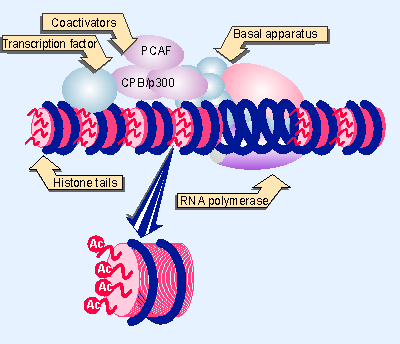 |
Figure 21.19 Coactivators may have HAT activities that acetylate the tails of nucleosomal histones. |
How do the steroid receptors activate transcription? They do not act directly on the basal apparatus, but function via a coactivating complex. The coactivator includes various activities. including the common component CBP/p300, one of whose functions is to modify the structure of chromatin by acetylating histones (see Figure 21.19).
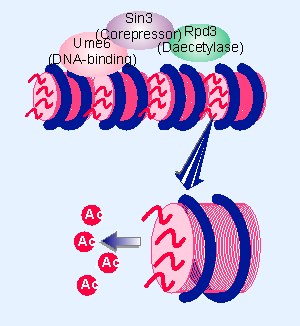 |
Figure 21.20 A repressor complex contains three components: a DNA binding subunit, a corepressor, and a histone deacetylase. |
All receptors in the superfamily are ligand-dependent activators of transcription. However, some are also able to repress transcription. The TR and RAR receptors, in the form of heterodimers with RXR, bind to certain loci in the absence of ligand and repress transcription by means of their ability to interact with a corepressor protein. The corepressor functions by the reverse of the mechanism used by coactivators: it inhibits the function of the basal transcription apparatus, one of its action being the deacetylation of histones (see Figure 21.20). We do not know the relative importance of the repressor activity vis-à-vis the ligand-dependent activation in the physiological response to hormone (Hörlein et al., 1995).
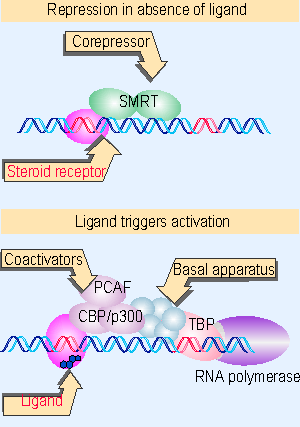 |
Figure 21.9 TR and RAR bind the SMRT corepressor in the absence of ligand. The promoter is not expressed. When SMRT is displaced by binding of ligand, the receptor binds a coactivator complex. This leads to activation of transcription by the basal apparatus. |
The effect of ligand binding on the receptor is to convert it from a repressing complex to an activating complex, as shown in Figure 21.9. In the absence of ligand, the receptor is bound to a corepressor complex. The component of the corepressor that binds to the receptor is SMRT. (We discuss the mechanism of repression later in this chapter.) Binding of ligand causes a conformational change that displaces SMRT. This allows the coactivator to bind.
| Reviews | |
| Evans, R. M. (1988). The steroid and thyroid hormone receptor superfamily. Science 240, 889-895. | |
| Yamamoto, K. R. (1985). Steroid receptor regulated transcription of specific genes and gene networks. Ann. Rev. Genet. 19, 209-252. | |
| Research | |
| Hörlein, A. J. et al. (1995). Ligand-independent repression by the thyroid hormone receptor mediated by a nuclear receptor corepressor. Nature 377, 397-404. | |
| Rastinejad, F., Perlmann, T., Evans, R. M., and Sigler, P. B. (1995). Structural determinants of nuclear receptor assembly on DNA direct repeats. Nature 375, 203-211. | |